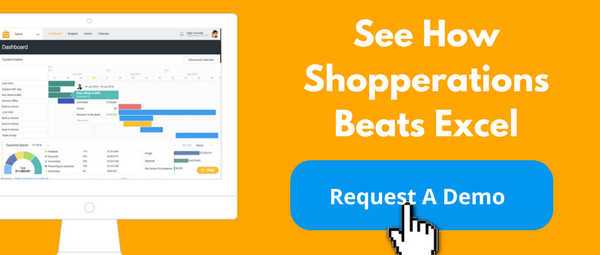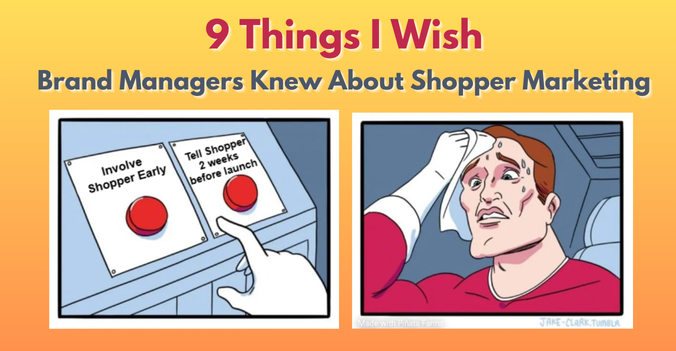
We are in the middle of July, a time when many CPG shopper marketers are rolling up their sleeves to prepare for national sales meetings, a big part of which is putting together preliminary marketing plans. This planning process is intended to align the brand retailer strategies and demonstrate how shopper teams will support their biggest retail customers with unique, strategic, compelling marketing campaigns. Sounds exciting, but why do most CPG shopper marketers dread planning these days?
Planning in CPG has always been stressful due to its sales/marketing duplicity, extremely fluid retail customer plans and vast scope. However, in the recent couple of years, primarily due to COVID, additional factors emerged that complicate CPG shopper marketing planning process. Here are the biggest four reasons:
1. Brand Plans And Funding Are Never Released In Time
Rapid expansion of digital and e-commerce technologies during COVID made the shift from traditional and in-store media toward digital campaigns even more radical. Since digital media doesn’t rely on movement of physical materials and advance planning and has amazingly short lead times, brand marketers can now be more responsive to market conditions, adjust their campaigns on the fly and shift dollars on a moment’s notice. That blessing, however, intensified an already existing tension between customer-facing marketing teams who require advance planning and sell-in and brand marketers, their internal clients. The constant complaint we hear from the shopper and commerce marketing teams that the brand plans, budgets and assets are not ready in time for customer sales meetings or retail execution is now stronger than ever. Retail planning, depending on a category, is done 4-12 months in advance, so shopper marketers feel increasingly frustrated and unprepared for the JBP calls.
How to fix this? Enable store-back planning. This idea is not new, in fact, it’s as old as the Shopper Marketing discipline itself, but it’s rarely implemented correctly. The role of retail in the success of CPG brands is increasingly important, so having their early input into the brand Annual Operating Planning (AOP) is key. Any brand plan that has been released without prior consultations with the key retail customers and customer-facing teams is doomed to mediocrity. When brand annual strategies and key initiatives are released to the field teams, they should see their fingerprints all over it. If they are surprised, you are doing it wrong.
2. Non-Stop Replanning Due To Supply Chain Breakdowns & Inflation
Early days of COVID were marked by unusually high demand for many CPG categories, which caused barren store shelves, cancelation of price promotions and in-store activities and e-commerce gold rush. Do you remember Q2 of 2020, how we had to scrap all the plans? While the consumer demand has evened out and panic buying is no longer something we as marketers have to deal with, two other signs of the post-pandemic world are marking CPG planning painful. Supply chain shortages in most industries are a real concern, driven primarily by the labor shortage. A strong inflation due rising energy and ingredient costs that started last year is now exacerbated by the war in Ukraine. This means that 2023 planning is shrouded in uncertainty and will likely turn into a continuous replanning activity rather than a once a year planning exercise.
You can’t eliminate the market uncertainty but you can embrace it and change the way your team does planning. Since the replanning is extremely likely, treat it as part of your regular process:
- Ask your customer-facing teams to submit bottom-up plans for the full year, even if the funding is not yet confirmed and even if plans change day by day.
- Offer your team a standardized, easy to use promotional planning system that will make it easy to a) share latest plans across the matrix; b) get funding approved, c) quickly communicate changes that are inevitable.
- If due to uncertainty, brands can’t commit to a full year budget in time for your programs to be sold into retail, ask for semiannual or quarterly funding releases.
- Avoid long-term vendor contracts or volume buy incentives. They sound lucrative on paper, but our experience shows that in times of uncertainty CPG buyers end up over-committing and wasting funds.
- Actualize your spend as soon as possible to redeploy unused funding and offer transparency to brands. Their ability to see what is planned vs spent will build trust and increase their willingness to fund your team’s ideas.
3. Retail Media AnD Its Fuzzy Ownership
Retail media emerged and grew to become a major part of brands’ marketing mix in the past couple of years. Since retail media looks both like customer marketing and digital media, the ownership of this new domain is getting very murky. I see CPGs who task traditional media agencies to tackle Retail Media, delegate Retail Media ownership to existing Shopper Marketing managers or even create an entirely new team to manage this new capability. The last scenario is the most frustrating since it creates yet another silo in an already extremely complex CPG matrix.
I argue that a modern Shopper Marketer must own retail media for their retail customers if they want to stay relevant both inside their CPG enterprise and on the job market. Yes, it’s complex, oftentimes unproven, very technical and may feel too tactical, but let’s face it: this is where the industry is heading. Having a partner Shopper Marketing agency who understands retail media and can teach your team new skills and flawlessly execute you retail media strategies wouldn’t hurt.
4. Half The Team Is Gone
High employee turnover & loss of info due to COVID resignations is a real concern for most knowledge workers. The CPG Shopper marketing industry is no exception. The wave of resignations has been very taxing for anyone who is left behind. Not only do they have to find and train a replacement but also manage the transition period and ensure that the campaigns already in the pipeline run smoothly. Most CPGs suffer more than they need to due to lack of a Shopper Marketing knowledge base, or a system of record where all plans are laid out in a way that anyone from the team can access and interpret. The typical makeshift excel spreadsheets that employees leave behind might have served them well because they created them for their own use, but they are often completely illegible for the next manager who takes over.
Having a planning solution for your team is no longer a luxury but a matter of business continuity and an essential part of your toolkit.
Do you and your team dread the planning process? What causes the most frustration and what have you found to be within your control to make this process more rewarding - please share in the comments below or email me at olga@shopperations.com.









